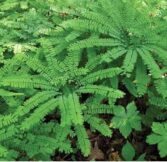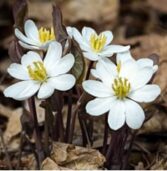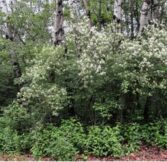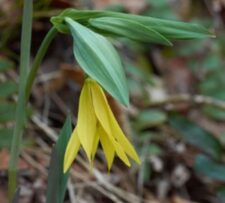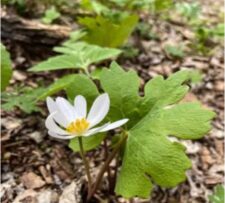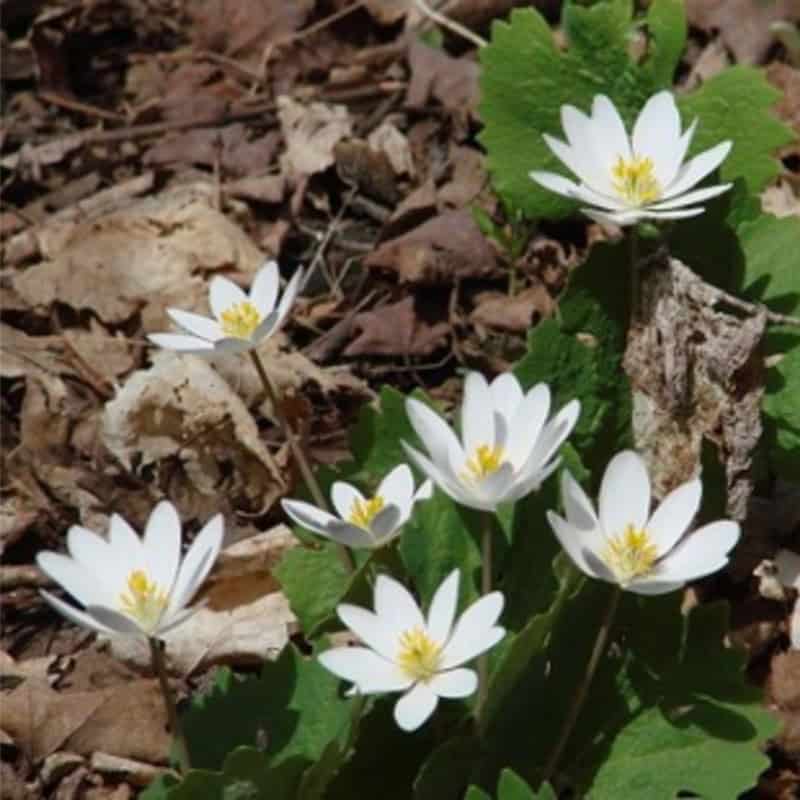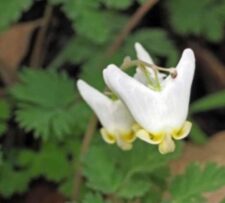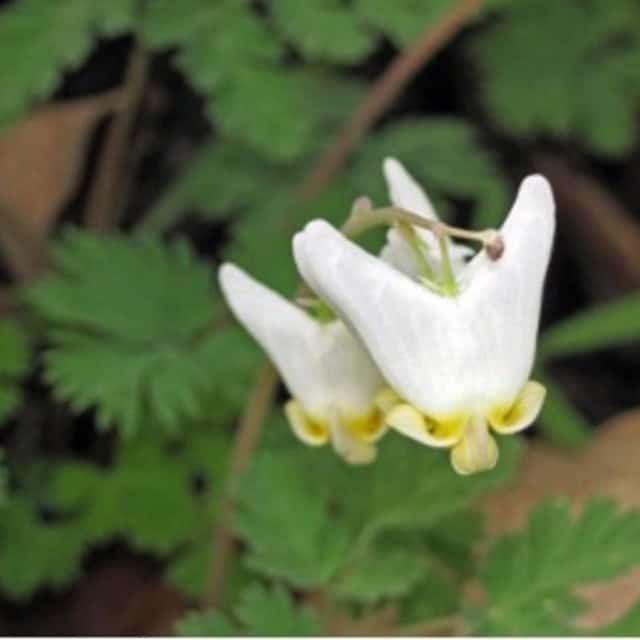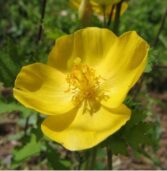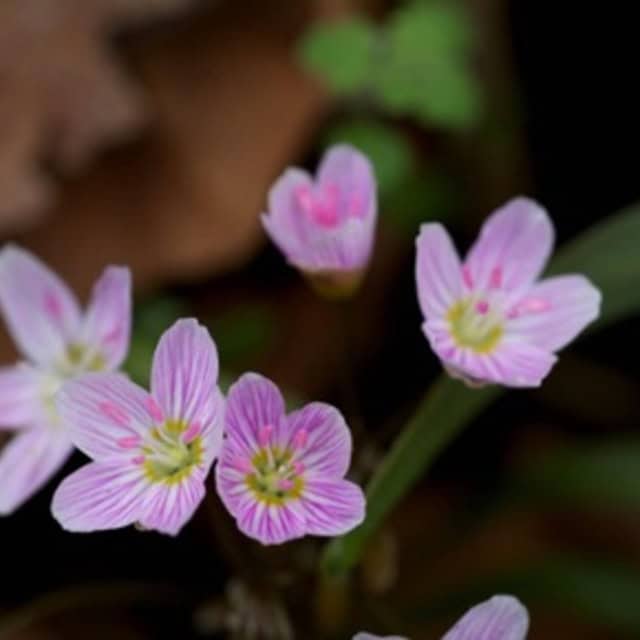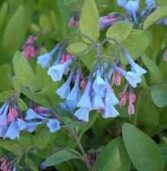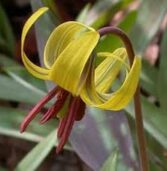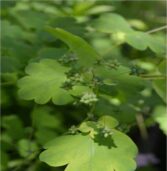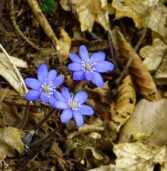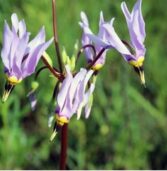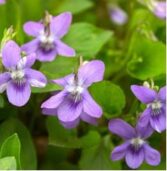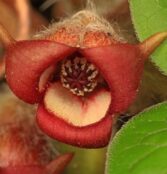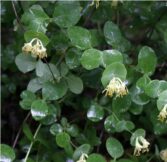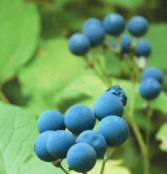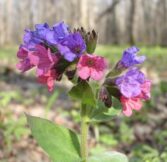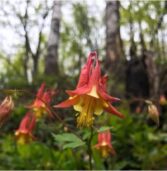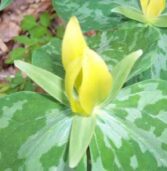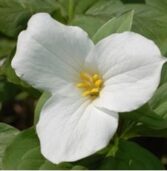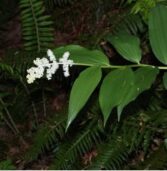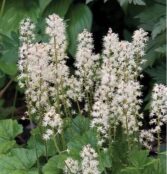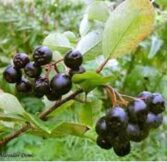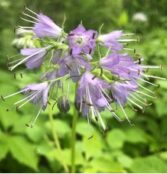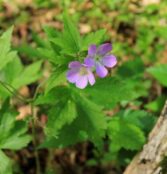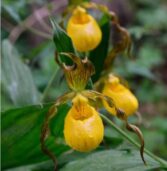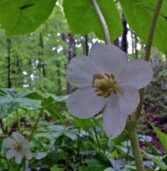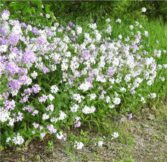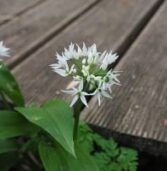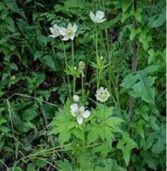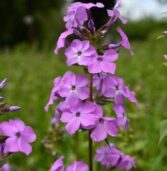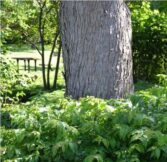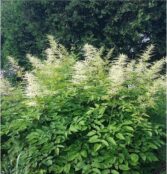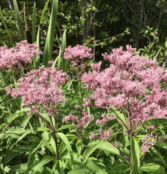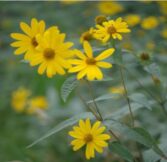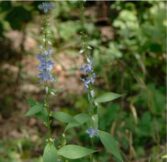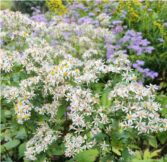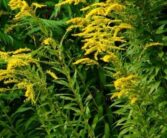Wildflower Plants
An Identification Guide
The majority of the plants growing in the Wildflower Garden were native to mid-central North America before the arrival of European settlers.
Some species are found throughout the garden, others occur naturally.
Northern MaidenHair Fern
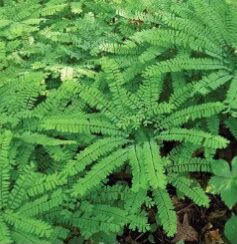
Northern MaidenHair Fern
Adiantum pedatum
- Life Cycle: Perennial
- Sun Exposure: Partial, Shade
The fine textured foliage of MaidenHair Fern (Adiantum pedatum) provides a perfect foil for other plants in the shade garden. Unique among ferns, the gently arching fronds seem to float suspended above the ground in a graceful fan-like shape. The floating illusion is maintained by a structure of very fine black stems that all but disappear against the background. Highly recommended for home landscaping Maidenhair fern is easy to grow, low maintenance, and highly resistant to damage from deer.
Ostrich Fern
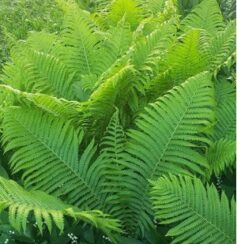
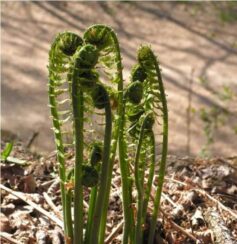
Ostrich Fern
Matteuccia struthiopteris
- Life Cycle: Perennial
- Sun Exposure: Partial, Shade
Large and vase-shaped, with beautifully textured fronds, Ostrich Fern creates acdramatic effect in the shade garden. Excellent for naturalizing, it is a good choice for stabilizing soils along shady stream banks and ravines. While many ferns prefer acid to neutral soils, Ostrich Fern is tolerant of a wider range of soils. In optimal moist conditions Ostrich Fern can spread and form denseccolonies. The emerging fiddlehead shoots are considered a delicacy, when cooked. Ostrich Fern is both, deer and rabbit resistant.
Twin Leaf
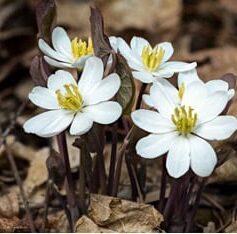
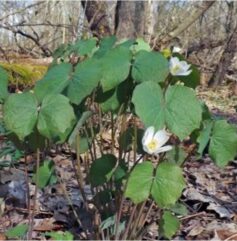
Twin Leaf
Jeffersonia diphylla
- Life Cycle: Perennial
- Bloom Time: March-May
- Sun Exposure: Shade
- Bloom Color: White
Diphylla flowers in early spring. These single white flowers resemble Bloodroot; however, the "twin leaves" of Jeffersonia diphylla are very distinct. Its flower stalks and leaves grow directly from an underground rhizome. Twin Leaf is not considered a Spring Ephemeral because the leaves remain photosynthetically active all summer. Twin Leaf can be found in hardwood forests, where it prefers to be shaded throughout the summer.
Lily of the Valley
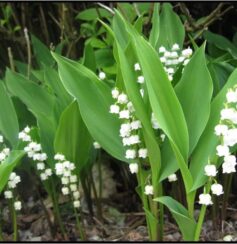
Lily of the Valley
Convallaria majalis
- Life Cycle: Perennial
- Bloom Time: April-May
- Sun Exposure: Partial, Shade
- Bloom Color: White
The stems of lily of the valley plants are covered with tiny white, nodding bell-shaped flowers that have a sweet perfume and medium-bright green leaves that are lance-shaped, 4 to 8 inches and 3 to 5 inches. Though lily of the valley is generally considered to be quite adaptable, the plant does have some specific considerations. Among these is its ability to spread throughout the garden, sometimes becoming invasive. Planting lily of the valley should be done with care, as the manner in which it is able to multiply can become quite problematic.
Grey Dogwood Bush
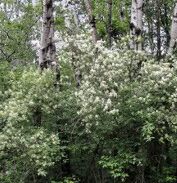
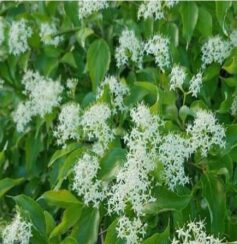
Grey Dogwood Bush
Cronus racemosa
- Life Cycle: Spring, Summer
- Sun Exposure: Partial, Shade
- Mature Height: 6-8 feet
Grey dogwood is a gray-stemmed native shrub that is excellent for naturalizing, especially in difficult sites. Although its suckering and spreading habit makes it impractical for formal plantings, it can be incorporated into the shrub border and useful as a mass planting. The Grey Dogwood has a dense, round flower-head that is creamy-white. The flowers develop into white fruits borne on bright red bracts. This plant then transforms come fall, showcasing purple foliage. This shrub adapts to dry and sandy soils.
Bellwort-Great Merrybells
Bellwort-Great Merrybells
Uvularia grandiflora
- Life Cycle: Perennial
- Bloom Time: April-May
- Sun Exposure: Partial, Shade
- Bloom color: Yellow
Bellwort is an excellent early-blooming native shade plant for the woodland garden, shaded border front, wildflower garden or naturalized area. It spreads slowly by rhizomes so you can achieve a mass planting look under shade trees or along wood margins in a relatively short amount of time. The Bellwort flowers and leaves have an overall droopy appearance when in bloom. However, after seeds are set, the leaves of Uvularia take on a different look, somewhat like a needle threading the stem through the leaves.
Bloodroot
Bloodroot
Sanguinaria canadensis
- Life Cycle: Perennial Ephemeral
- Bloom time: April-May
- Sun Exposure: Partial, Shade
- Bloom Color: White
Bloodroot emerges from the ground in woodlands before the trees leaf out. Plants display their beauty in 2 stages:
- Stunning white blossoms appear for a very short time in early spring, emitting a wonderful fragrance that attracts many kinds of early-flying pollinators. The stems of Bloodroot have a reddish juice (see photo) that is toxic to herbivores.
- At the flowering stage, a light green leaf is wrapped around the stem of the flower.
When the flower fades, the leaf opens in a very unique shape as large as 6" in diameter. Bloodroot will go dormant mid-summer.
Dutchman’s Breeches
Dutchman's Breeches
Dicentra cucullaria
- Life Cycle: Ephemeral
- Bloom Time: April-May
- Sun Exposure: Partial, Full Shade
- Bloom color: White
Dutchman's Breeches is a wildflower of the Dicentra clan, similar to the Dicentra bleeding heart. Blooms (called spurs) are similar to those of the bleeding-heart plant, but shaped differently, more like a pair of pantaloons than a heart -- thus, the common name of Dutchman's Breeches. Dutchman's Breeches wildflower is often found growing with squirrel corn and together earn the nickname,”boys and girls.” The plant propagates through underground rhizomes or seeds carried by bumblebees.
Celandine Poppy

Celandine Poppy
Stylophorum diphyllum
- Life Cycle: Perennial
- Bloom Time: April-May
- Sun Exposure: Partial, Shade
- Bloom Color: Yellow
Also known as Wood Poppy, this attractive woodland plant will grow well in zones 4-8 in with little to no care in rich woodland soils. It can tolerate drier, sunnier sites with some care. A welcome, well-deserved sight in April after a long winter. After seeds drop out of its large, hairy pods, Celandine Poppy will mostly disappear as taller, summer shade plants surround it. Seedlings will emerge in distant areas from the mother plant as it is thought that ants aid in seed dispersal.
Spring Beauty
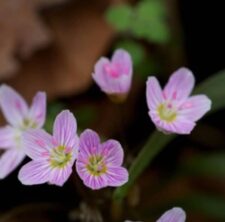
Spring Beauty
Claytonia virginica
- Life Cycle: Perennial, Ephemeral
- Bloom Time April-May
- Sun Exposure: Partial, Shade
- Bloom Color: Pink
When the snow starts to melt and early spring wildflowers begin to emerge, the beauty of the spring is all around us. What better wildflower to enjoy at this time than Spring Beauty (Claytonia virginica)!
The early flowering of this small woodland plant is great for pollinators including manyspecies of bees. Because Spring Beauty can survive in more degraded habitats compared to most spring-blooming woodland species, it is still relatively common to see wild populations throughout the Midwestern and Eastern US.
The flower color is pale pink from a distance but a close look reveals five white petals striped with pink.
Virginia Bluebells

Virginia Bluebells
Mertensia virginica
- Life Cycle: Ephemeral
- Bloom Time: April-May
- Sun Exposure: Partial, Shade
- Bloom Color: Blue
One of the most beautiful species of spring ephemerals are Virginia bluebells (Mertensia virginica). These lovely plants are in the family Boraginaceae, which makes them relatives of other familiar species like Forget-me-not, Lungwort, and Comfrey. Bluebells enjoy rich, well-drained soils where they can form large colonies over time. Growing fast, the flower shoots quickly give way to some of the most beautiful flowers east of the Mississippi.
The flowers start off pink and gradually turn over to their famous shade of light blue as they mature. A colony of bluebells is truly an amazing sight to behold! The blooms will last for many weeks in early spring (April and May) and will go dormant by mid-summer.
Virginia Bluebells prefer soils typical of a woodland - rich and a little on the wet side.
Toothwort
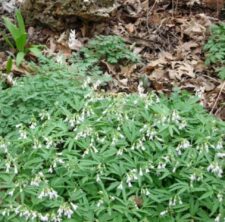
Toothwort
Cardamine concatenata
- Life Cycle: Perennial
- Bloom Time: April-May
- Sun Exposure: Shade
- Bloom Color: White
Toothwort is one of the first plants to bloom in spring; providing much-needed nectar to early spring-flying insects. Dozens of white to pale-pink flowers will cover a healthy colony of plants just a few years after transplant or division.
It is also called Cutleaf Toothwort and Dentaria laciniata.
It will go dormant mid-summer.
Trout Lily
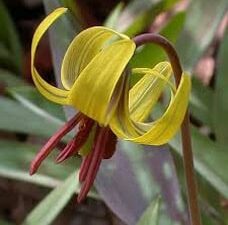
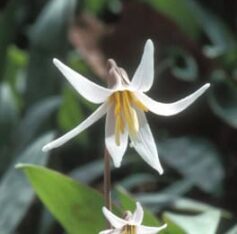
Trout Lily
Erythronium
- Life Cycle: Ephemeral
- Bloom Time: April-May
- Sun Exposure: Shade
- Bloom Color: Yellow, White
Trout Lily has tulip-like green leaves with silvery-maroon mottled markings. The plants will spread slowly to form colonies, but can take many years to flower.
A single, very attractive flower will bloom for just a few days on mature plants early in the spring. The plant will fade into dormancy by mid-summer. Also called Dog Tooth Violets, these lovely spring ephemerals are just what you need to see after a long, dreary winter. White Trout Lilies are spreaders. Their underground roots will bud off new plants and in only a few seasons, a couple plants can spread into many. Trout Lilies offer pollinators a much needed meal during a time when little else is available.
Early Meadow Rue

Early Meadow Rue
Thalictrum dioicum
- Life Cycle: Ephemeral
- Bloom Time: April-May
- Sun Exposure: Partial, Shade
- Bloom Color: Green
Early Meadow Rue is an excellent shade-garden plant. Use it to fill in where many of your early spring woodland flowers will go dormant. It is valued for its delicate green fern-like foliage, which will last spring through fall. The greenish-yellow flowers resemble little tassles and bloom in early spring when the leaves have not quite opened and the canopy of the trees above is not yet shading the woodland floor. Early Meadow Rue can take partial sun as well and thrives in moist through well-drained soils. Other common names in use include Quicksilver Weed.
Hepatica, Sharp-Lobed

Hepatica, Sharp-Lobed
Hepatica acutiloba
- Life Cycle: Ephemeral
- Bloom Time: April-May
- Sun Exposure: Partial, Shade
- Bloom Color: White, Pink, Blue
As the first spring ephemeral to bloom in the forest, Sharp-lobed Hepatica is a delightful sight after a long winter. John Burroughs, the famous 19th century American naturalist, once said, “There are many things left for May, but nothing fairer, if as fair, as the first flower, the hepatica..” This petite little plant can be a variety of colors including white, pink and blue.
Hepatica can be identified by the distinctive, mottled leaves which turn a crimson color in the fall. In late winter, the bright red color of last year's leaves are a good indication of where the new blooms will appear come spring. The appearance of the leaves has inspired another common name, "Liverleaf." The name references the perceived similarity of the leaf shape to the human liver. Ancient herbalists believed in the "Doctrine of Signatures," the idea that the cures to medical ailments could be found in the plants that resembled the diseased human body part. Hepatica was creatively imagined to be shaped like a liver, and as such, it was historically used to treat ailments of the liver. Like many plants believed to have medicinal qualities, Hepatica was almost over-harvested to the brink of extinction. Modern medical science has shown Hepatica to have no medical efficacy, and the Doctrine of Signatures has also since been proven to be pseudoscience.
Midland Shooting Star
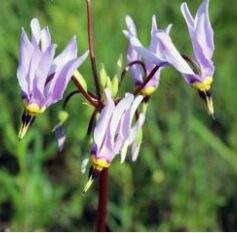
Midland Shooting Star
Dodecatheon meadia
- Life Cycle: Ephemeral
- Bloom Time: April-June
- Sun Exposure: Full, Partial
- Bloom Color: White
The early spring plants tend to get the most attention because we so need to see flowers at that time of year. Shooting Stars deserve the acclaim. They are true spring ephemeral of the prairie; they are completely done with their season and go dormant by mid summer. They have beautiful mahogany colored seed pods that are often not noticed because other tall species have over-topped them by that time. Midland Shooting Star, often called just 'Shooting Star', can become very robust with a few dozen flowers coming out of each plant, especially in moist, rich soils.
Common Violet

Common Violet
Viola sororia f. rubra
- Life Cycle: Perennial
- Bloom Time: April-June
- Sun Exposure: Full, Partial, Shade
- Bloom Color: Blue, Bi-color blue-white
Common violet is a stemless, herbaceous, perennial wildflower that is well known for its heart-shaped foliage, blue-violet flowers in spring and summer, and ability to rapidly spread in clumps throughout the landscape. It does well in many tough growing situations and pops up nearly everywhere in the Midwest.
Wild Ginger
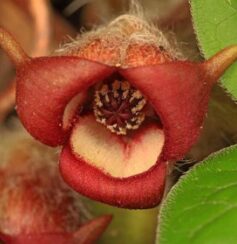
Wild Ginger
Asarum canadense
- Life Cycle: Perennial
- Bloom Time: April-June
- Sun Exposure: Shade
- Bloom Color: Red
Best known for its use as an attractive, low-growing ground cover in a shaded, or dappled light setting, Wild Ginger is also deer-resistant.
It will max out at about 6" in height and the large heart-shaped leaves can be 6" in diameter. The leaves are shiny when fully opened and the stems are hairy. Unlike many early spring woodland plants, Wild Ginger will keep its foliage throughout the season; it will not go dormant so it is a good species to plant among the spring ephemerals that do go dormant. An attractive dark red flower will appear under the plant early spring but will fade fairly quickly.
Grape Honeysuckle
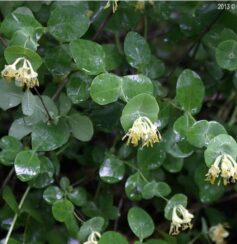
Grape Honeysuckle
Lonicera reticulata
- Life Cycle: Perennial
- Bloom Time: April-June
- Sun Exposure: Partial, Shade
- Bloom Color: Yellow, Pink
Grape honeysuckle is a twining woody vine, sometimes somewhat bushy when no support is present. Native to Iowa woodlands.
Flowers in clusters at the end of stems on new growth; clusters arranged in 2–6 whorls or layers, which are usually separated along the stalk; flowers pale yellow, fragrant, ¾– to 1-inch long, tubular, slender, noticeably enlarged on one side at the base, smooth on the outside, hairy inside; tip of tube strongly spreading into 2 lips, one lip with a single narrow lobe, the other lip with 4 short lobes; stamens protrude beyond flower.
Blue Cohosh
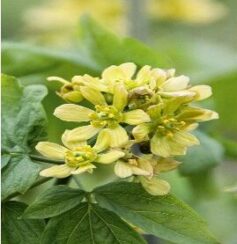
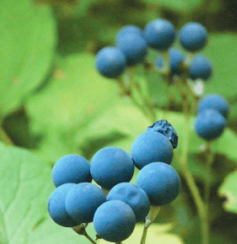
Blue Cohosh
Caulophyllum thalictroides
- Life Cycle: Perennial
- Bloom Time: April-June
- Sun Exposure: Partial, Shade
- Bloom Color: Blue, Green
Blue Cohosh is a choice woodland native, treasured for its lacy blue-green foliage and deep blue berries. This beautiful shade garden plant prefers a soil with abundant organic matter from decaying leaves and consistent moisture. In spring, a cluster of yellow flowers appear at the branching "Y" of the stem. The flowers are intricate and interesting, but small and somewhat inconspicuous. The berries that follow, however, are very showy. Starting out green, the berry clusters turn blue as they mature later in the summer. In fall the berries persist as the plant foliage turns bright green-gold. Combine this shade-loving species with lower growing wildflowers.
Lungwort Pulmonaria
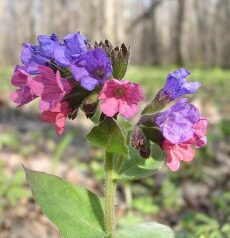
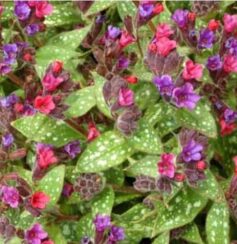
Lungwort Pulmonaria
(non-native)
- Life Cycle: Perennial
- Bloom Time: April-June
- Sun Exposure: Shade
- Bloom Color: Purple, Pink, Blue
Pulmonaria hail from a native range encompassing much of Europe and into Russia. In the wild, they usually grow in deciduous woodlands.The flowers, most of which emerge usually either pink or violet, typically change to blue as they age. The name pulmonaria arose from the foliage, which is often green with white spots, resembling a diseased lung ... hence the common name lungwort.
Bishop's Cap
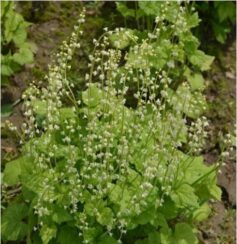
Bishop's Cap
Mitella diphylla
- Life Cycle: Perennial
- Bloom Time: April-June
- Sun Exposure: Partial, Shade
- Bloom Color: White
You'll fall in love with the tiny snowflake-like, fringed flowers atop the thin stems of Bishop's Cap. Other easily identifiable characteristics include a single pair of leaves half way up the stem (hence the species epithet "diphylla," or "two-leaves"). The name Bishop's Cap refers to the seed capsules, which are split open to resemble the deep cleft in a bishop's miter. The upright capsules are designed for a type of seed dispersal known as splash-cup dispersal. When raindrops strike the capsule, the splash sends seeds flying up to a meter away. Bishop's Cap can tolerate drier full shade sites, although its preference is for medium soils and partial sun in the spring months.
American Columbine
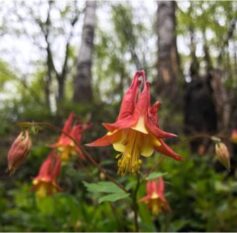
American Columbine
Aquilegia canadensis
- Life Cycle: Perennial
- Bloom Time: April-June
- Sun Exposure: Partial, Shade
- Bloom Color: Red
Columbine, also called Red or American Columbine, is the larval host plant of the Columbine Duskywing. The colorful flowers are red flowing into yellow. Besides being an early bloomer, Columbine will tolerate a large range of soil and sun types, so you'll have success with it in full sun as well as shade. The seeds of Aquilegia are shiny black and smooth - like
tiny black pearls. They can bounce on hard soil surfaces, aiding in their distribution.
Yellow Trillium
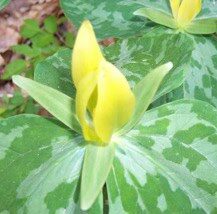

Yellow Trillium
Trillium luteum
- Life Cycle: Perennial
- Bloom Time: April-June
- Sun Exposure: Partial, Shade
- Bloom Color: Yellow
Easily grown in rich medium soils, Trillium luteum is tolerant of heavy clay with decent topsoil. The plants are very long-lived, up to 25 years, but can take a few years to mature. Yellow Wakerobin Trillium spreads slowly if left undisturbed in the shade garden or naturalized wooded area. It combines well with other spring wildflowers such as Virginia Bluebells, Jacob's Ladder, and Wild Blue Phlox. The foliage will die back, so plant them with along with shade-loving ferns to share their place until they reappear the following spring.
White Trillium
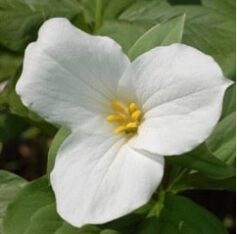
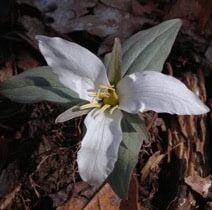
White Trillium
Trillium grandiflorum
- Life Cycle: Perennial
- Bloom Time: April-June
- Sun Exposure: Partial, Shade
- Bloom Color: White
Commonly called White Trillium, Great White Trillium, or Snow Trillium, this plant is a "must-have" for any woodland area in the Midwest or Northeast. Trillium grandiflorum's stunning white flowers can reach 4" in diameter and will take on an equally head-turning pink hue when reaching the end of their bloom cycle.
The common name Wake Robin is less used today, but it no doubt referred to the early April and May bloom time, corresponding with the appearance of the Robin. Trilliums are members of the Lily family.
Jacob's Ladder

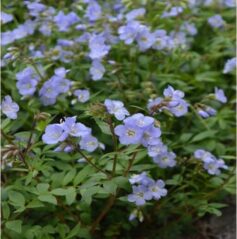
Jacob's Ladder
Polemonium reptans
- Life Cycle: Perennial
- Bloom Time: April-June
- Sun Exposure: Full, Partial, Shade
- Bloom Color: Blue
Like many spring blooming natives, the bloom time on Jacob's Ladder is short but sweet. The few short weeks in April or May that the flowers appear, the plant will be covered in blooms that range from shades of pink to blue. Jacob's Ladder will grow in full sun if it has adequate moisture, but it prefers woodlands (almost full shade) and woodland edges (partial shade.) A mature plant will only reach heights of 1' and is deer resistant.
Other common names include Bluebell, Greek Valerian, and Skunk Weed.
Trillium Toad
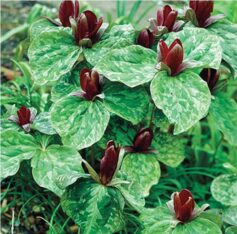
Trillium Toad
Trillium sessile
- Life Cycle: Perennial
- Bloom Time: April-June
- Sun Exposure: Partial, Shade
- Bloom Color: Red
A charming addition to shady spaces or sun-dappled gardens, Toad Trillium, also known as Trillium sessile, produces small tri-petaled blooms in a range of hues from dark red to maroon to brownish-purple. The little flowers pop against highly ornamental mottled foliage, giving the entire area a dynamic look sure to please. Plant in groups under deciduous trees or between evergreen shrubs to brighten up the scene with color and light. Blooms appear from April to May in zones 4-8. Butterflies love this low-growing perennial and will visit the landscape often. Trillium is a wildflower native to the U.S. and grows quite readily and dependably.
False Solomon Seal
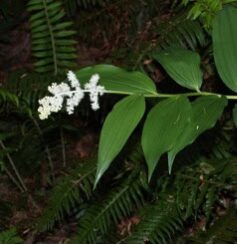

False Solomon Seal
Maianthemum stellatum
- Life Cycle: Perennial
- Bloom Time: April-June
- Sun Exposure: Full, Partial, Shade
- Bloom Color: White
Starry Solomon's Plume is very easy to grow. It is rhizomatous and spreads readily in many sun and soil situations, between 1-2' per year. Attractive leaves, flowers and green berries with maroon stripes that eventually turn bright red give the plant 3-season interest. Narrower leaves and spike-like rather than feathery white flowers differentiate it from Solomon's Plume (Maianthemum racemosa).
Other common names are Starry False Solomon's Seal and Starry False Lily of the Valley.
Foam Flower
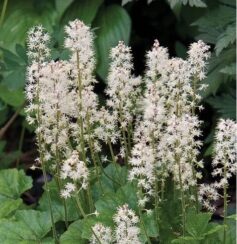
Foam Flower
Tiarella cordifolia
- Life Cycle: Perennial
- Bloom Time: May-June
- Sun Exposure: Partial, Shade
- Bloom Color: White
Foam flower is one of the showiest spring wildflowers, native to the woodlands and forests of the eastern United States. A beautiful addition to the Wildflower Garden, the starry white flower spikes are often accented with a tinge of pink. Evergreen in the southern parts of its range, the handsome lobed foliage stays attractive all summer and turns hues of red and bronze in the fall. The dense foliage hugs the ground and flower spikes rarely exceed one foot.
Black Chokeberry Bush

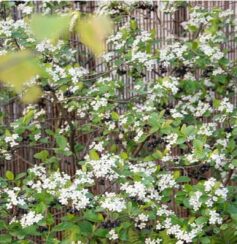
Black Chokeberry Bush
Aronia melanocarpa
- Bloom Time: May-June
- Sun Exposure: Sun, Partial
- Bloom Color: White
Black Chokeberry (Aronia melanocarpa) is graced with an abundance of beautiful white flowers with pink anthers, for several weeks in May. In autumn the vibrant leaf color is a major attraction, with tones of electric orange, red and burgundy. The multi-stemmed form with vase-shaped branching has a rounded top, and the mature size is typically around five or six feet tall.
Jack-in-the-Pulpit

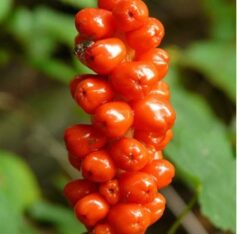
Jack-in-the-Pulpit
Arisaema triphyllum
- Life Cycle: Perennial
- Bloom Time: April-July
- Sun Exposure: Partial, Shade
- Bloom Color: Green, Red
Jack-in-the-Pulpit is an excellent woodland garden plant. It thrives under a variety of conditions, but grows best in rich soil, shady, seasonally wet locations. The "Jack" is the spongy cylindrical structure, inside a leaf-like structure that is rolled into a deep cup with an overhanging roof, the "pulpit". The plant is said to have a burning, peppery taste so herbivores will not eat it but the berries are a food source for birds. These berries form mid-summer and are smooth, shiny green, 1 cm wide clustered on the thickened spadix, turning a bright red color before the plants go dormant early fall.
Virginia Waterleaf
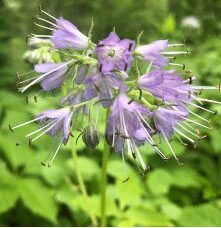
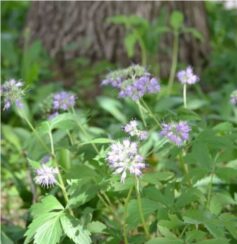
Virginia Waterleaf
Hydrophyllum virginianum
- Life Cycle: Perennial
- Bloom Time: May-June
- Sun Exposure: Partial, Shade
- Bloom Color: Purple
The name Hydrophyllum means 'water leaf.' Notice how the early season leaves of the Virginia Waterleaf appear to have water droplets. Virginia Waterleaf's small, light purple, bell-shaped flowers bloom from May to June. These small flowers attract mainly bees, but also some other pollinators. Virginia Waterleaf is a classic Northwoods plant. It prefers partial sun to full shade and medium soils. In its native range, you can find Virginia Waterleaf in wooded areas, specifically deciduous woodlands.
Wild Geranium
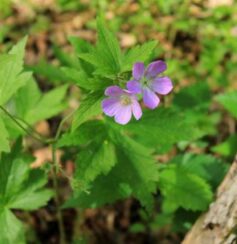
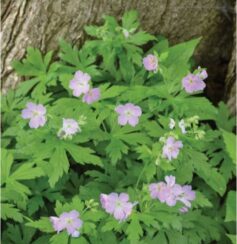
Wild Geranium
Geranium maculatum
- Life Cycle: Perennial
- Bloom Time: April-July
- Sun Exposure: Full, Partial, Shade
- Bloom Color: Purple
Wild Geranium is native to much of eastern North America, it never disappoints. It has lovely dissected leaves, beautiful pinkish-purple flowers, and it readily spreads, forming stunning patches that everything from bees to butterflies can't resist. Interestingly, Geranium maculatum has a unique way of spreading its seeds. Each seed is packed into a pod and the pods are attached to a structure that resembles a crane's bill. As the bill dries, it literally catapults the seeds away from the parent plant. Each seed has a small tail-like structure attached to it that bends and moves in response to changes in humidity, which helps to drive the seed into the soil where it can safely germinate.
Wild Blue Phlox
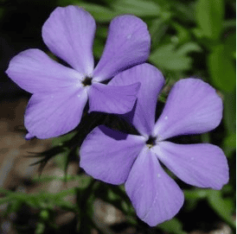
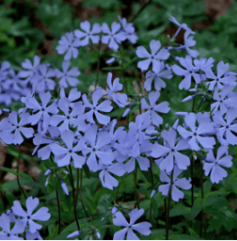
Wild Blue Phlox
Phlox divaricata
- Life Cycle: Perennial
- Bloom Time: May-June
- Sun Exposure: Partial, Shade
- Bloom Color: Blue
This is a Phlox for shade or partial shade and medium to drier soils. Wild Blue Phlox is rhizomatous and will spread slowly but steadily. It is also commonly referred to as Blue Phlox, Woodland Phlox, or Louisiana Phlox. Some may call it Wild Sweet William, but that is the common name we give to Phlox maculata. The flowers, atop sticky stems, are slightly fragrant and range in color from pale blue to lavender to violet. Deer seem to have little interest in Phlox, but rabbits especially like Wild Blue.
Downy Yellow Violet

Downy Yellow Violet
Viola pubescenc
- Life Cycle: Perennial
- Bloom Time: May-June
- Sun Exposure: Full, Shade
- Bloom Color: Yellow
Downy Violet is a clump-forming perennial boasting bright yellow flowers with tiny black whiskers painted toward the throat. Blooming late spring and early summer. The blossoms are borne solitary on short, leafy stems and rise above sturdy foliage of heart-shaped, toothed leaves. Both stems and leaves are softly hairy, hence the common name.
Downy violet remains green throughout the summer if there is enough moisture, otherwise it goes dormant.
Sweet Cicely
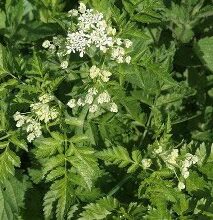
Sweet Cicely
Osmorhiza claytonii
- Life Cycle: Perennial
- Bloom Time: May-June
- Sun Exposure: Shade
- Bloom Color: White
Sweet Cicely is a perennial that is part of the carrot family. It grows in the wild in mesic forests and on wooded slopes. The white flowers of this plant can be found at the top clustered into four to seven flowers each. The leaves resemble ferns; dark green leaves are compounded in threes one or two times and have serrated edges. All surfaces of Sweet Cicely are hairy, especially on veins on the underside of the leaves. Towards the end of the season dry brown seeds appear that split into two when ripe.The roots, when dug, are said to give off an anise-like flavor.
Yellow Lady's Slipper
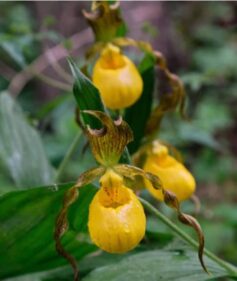
Yellow Lady's Slipper
Cypripedium parviflorum var. pubescens
- Life Cycle: Perennial monocot
- Bloom Time: May-June
- Sun Exposure: Partial, Shade
- Bloom Color: Yellow
The large yellow lady’s-slipper is a stately wildflower, native to Iowa, that grows in a number of habitats—in moist and mesic woods, on hillsides, and bogs. But because orchids have highly specific requirements for germination, growth, and reproduction ( up to 16 years to bloom), the conversion of natural lands for agricultural development has resulted in such loss of habitat that all but a handful of orchid species are now considered threatened or endangered.
May Apple
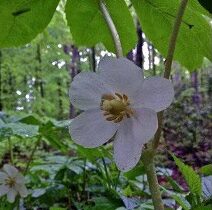
May Apple
Podophyllum peltatum
- Life Cycle: Perennial
- Bloom Time: May-June
- Sun Exposure: Partial, Shade
- Bloom Color: White
For those of you that struggle with what to plant under pines that leave dry, semi-shady conditions, They can be quite aggressive, but have attractive, short, green foliage that look almost like umbrellas to protect the large white flower which blooms in May and June. Also called Devil's Apple, Hog-apple, and Indian Apple.
Caution: May Apple root can be toxic and should only be used by experienced herbalists. The seeds and rind are not edible, and are said to be poisonous. The whole plant, apart from the ripe fruit, is highly poisonous in large doses.
Dames Rocket

Dames Rocket
Hesperis matronalis
- Life Cycle: Biennial
- Bloom Time: May-June
- Sun Exposure: Full, Partial, Shade
- Bloom Color: White, Purple
[INVASIVE] Dame’s rocket (Hesperis matronalis) resembles phlox in height and color but is in a different plant family entirely, the Mustard family (Brassicaceae) while Phlox is in the Phlox family (Polemoniaceae). Perhaps the most distinguishing difference between the two is that Dame’s rocket has four petals, while phlox has five. While beautiful, dame’s rocket does have an invasive nature as evidenced by the prolific pockets of plants readily seen this time of year. Don't be fooled by the beauty of Dame's rocket. This plant will not make a great addition to Iowa cutting or perennial gardens.
Wild Leek
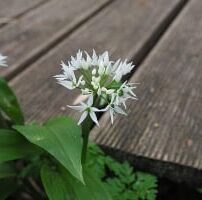
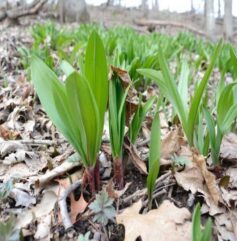
Wild Leek
Allium tricoccum
- Life Cycle: Perennial
- Bloom Time: June-July
- Sun Exposure: Partial, Shade
- Bloom Color: White
Wild Leeks are renowned for their edible bulbs and leaves that have a mild onion flavor. The foliage dies back as the flower stalk emerges. Throughout June and July, buds burst out of their papery confines and open to reveal creamy-white flowers that bloom in a bountiful, domed cluster. This species provides welcome pops of brightness in the shade garden after most ephemerals are spent. As the summer months progress, the blossoms dry and showcase pearly black seeds.
This seedhead will often persist throughout the fall and winter months. This plant prefers typical woodland conditions with dappled sunlight sustaining the Wild Leek's foliage in early spring, and deeper shade as the trees leaf out while the plant flowers.
Thimbleweed
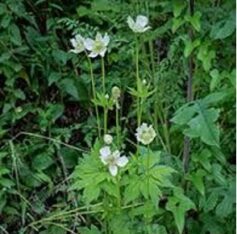
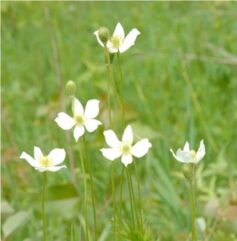
Thimbleweed
Anemone virginiana
- Life Cycle: Perennial
- Bloom Time: June-August
- Sun Exposure: Full, Partial, Shade
- Bloom Color: White
Tall Thimbleweed has long-lasting, off-white flowers, and as with the other anemones, what appear to be petals are actually colored sepals. The thimble-like seed heads are ornamental, becoming fluffy when they disperse their seed. This makes them fun multi-season plants of interest. Tall thimbleweed prefers open woods and clearings.
Before the seed head is developed, it is best to look at the leaves along the flowering stem. Anemone virginiana usually has 3 leaves at the base of the inflorescence, and a pair of leaves on each flower stem.
Wild Sweet William

Wild Sweet William
Phlox maculata
- Life Cycle: Perennial
- Bloom Time: June-August
- Sun Exposure: Partial
- Bloom Color: Purplish-Pink
Phlox maculata is rarely found in the wild due to habitat degradation and destruction. It also has steep competition from Dame’s Rocket, an invasive, non-native plant in the mustard family. The easiest way to distinguish Phlox is the 5 flower petals, whereas Dame's Rocket only has 4. Dame's Rocket also has alternate leaves, while native Phlox have opposing leaves.
Other common names in use: Speckled Phlox, Spotted Phlox, Meadow Phlox
Native Dwarf Honeysuckle
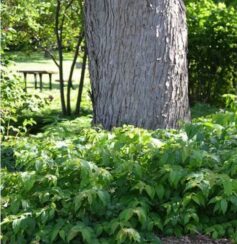
Native Dwarf Honeysuckle
Diervilla lonicera
- Bloom Time: June-August
- Sun Exposure: Partial, Shade
- Bloom Color: Yellow
Honeysuckle Dwarf Bush is a hardy, rugged shrub with dependable yellow summer blooms that redden as they are pollinated. Two plants are needed for pollination, and there's plenty of pollinators out there ready to help out. In fall, the leaves turn lovely shades of red and purple. I often recommend Honeysuckle Dwarf Bush as a low hedge, perhaps lining a driveway.
Goat's Beard
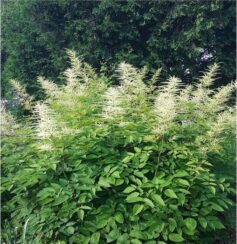
Goat's Beard
Aruncus Dioicus
- Life Cycle: Perennial
- Bloom Time: May through mid-July
- Sun Exposure: Partial, Shade
- Bloom Color: Cream White
Goat's beard, also known as bride's feathers, is a perennial forb in the rose (Rosaceae) family. Native to the northern hemisphere in North America, this plant generally grows in moist woods, meadows, and along streams. It is also known to grow in moist to wet ravines, rocky ledges, and avalanche chutes. Goat's beard is a very showy plant, growing up to six feet tall in large bushy clumps. Feathery clusters of tiny, cream-colored flowers grow on long branched spikes high above the leaves.
Sweet Joe Pye Weed
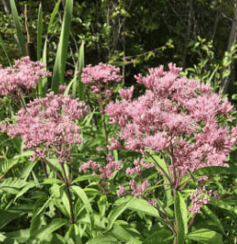

Sweet Joe Pye Weed
Eupatorium purpureum
- Life Cycle: Perennial
- Bloom Time: August-September
- Sun Exposure: Partial, Shade
- Bloom Color: Pink, Purple
Perfect for shady butterfly gardens, Eupatorium purpureum thrives in semi-shade and woodland edges, as well as in full sun. The large pink flowers are a favorite nectar source for Monarchs, Swallowtails and many other butterflies. The textured foliage looks good all summer long. "Sweet Joe" is an excellent, well-behaved garden plant with a shallow fibrous root that won't interfere with other garden perennials. A great contributor whether massed, naturalized or in the border garden.
Woodland Sunflower
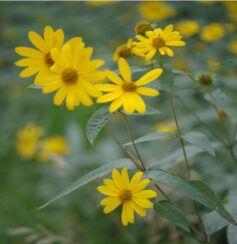
Woodland Sunflower
Helianthus divaricatus
- Life Cycle: Perennial
- Bloom Time: July-September
- Sun Exposure: Partial, Shade
- Bloom Color: Yellow
Woodland Sunflower, Helilanthus divaricatus, features 2-inch wide flowers with bright yellow rays and slightly darker yellow centers, blooming from midsummer to fall. Tolerant of a wide range of soil conditions, it is easily grown in average, dry to medium well-drained soil in part shade, and is especially suitable for dry, open woodland or savanna. Over time, it will spread to form colonies and may not be suitable for smaller planting areas. Divide it every 3-4 years to control spread and maintain vigor.
American Bellflower
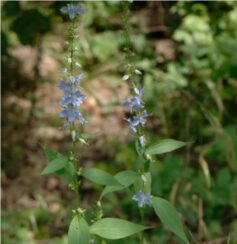
American Bellflower
Campanula americana
- Life Cycle: Biennial
- Bloom Time: July-October
- Sun Exposure: Partial, Shade
- Bloom Color: Blue
Tall Bellflower, or American Bellflower, reaches from three to five feet in height, its blue-violet blooms providing a bright late-summer accent to savanna or woodland plantings. Self-seeding, it is either annual or biennial by habit, seemingly depending on when germination occurs. First-year plants are tight rosettes of heart-shaped leaves that shoot up the following spring to form tall stems. Because Campanula americana is the only bellflower with wide-spread petals, a petal tube that elongates with age and stamens that extend over the petals, it often is assigned the special designation Campanulastrum americanum.
Woodland Aster

Woodland Aster
Aster divaricatus
- Life Cycle: Perennial
- Bloom Time: August-September
- Sun Exposure: Partial, Shade
- Bloom Color: White
White Woodland Aster (Aster divaricatus) is one of the first asters to bloom, brightening up the shade garden from late summer into fall. Numerous small daisy-like flowers with white petals and yellow centers are borne in loose clusters at the ends of the stems. Typically around 3’ feet high with an upright habit and spreading branches, the stems are slender and often reddish in color. The dark colored stems contrast beautifully with the white flowers, and the deep green foliage looks great all season.
Zig Zag Goldenrod
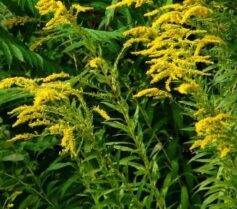
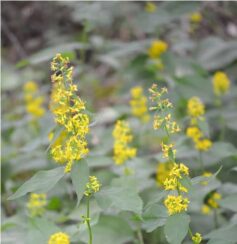
Zig Zag Goldenrod
Solidago flexicaulis
- Life Cycle: Perennial
- Bloom Time: August-October
- Sun Exposure: Partial, Shade
- Bloom Color: Yellow
Zig Zag Goldenrod gets its name from the way that its stems "zig zag" from leaf to leaf. These leaves are bluntly toothed all along the stem with the middle leaves usually the largest at 6" long and 4" wide. The small flowers appear from late summer to early fall in a cluster near the top of the plant. Zig Zag Goldenrod can be aggressive. Sadly, goldenrods often get blamed for causing the dreaded hayfever. This is simply not true. Their pollen is quite large and sticky so as to better adhere to the body of visiting insects. Because of this, goldenrod pollen cannot become airborne and can never make its way into your sinuses. We cannot stress enough how important goldenrods are on the landscape.
Witch Hazel Shrub
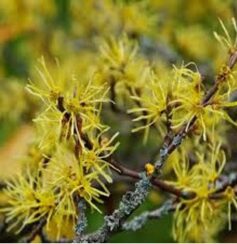
Witch Hazel Shrub
Hamamelis virginiana
- Life Cycle: Perennal
- Bloom Time: October-November
- Sun Exposure: Partial, Shade
- Bloom Color: Yellow
Witch Hazel is an attractive fall-blooming, native, low-maintenance shrub/small tree that grows best in part shade and medium-wet, slightly acidic soils. Its most notable feature is the fall yellow flowers, one of the last to appear, and are very fragrant.

